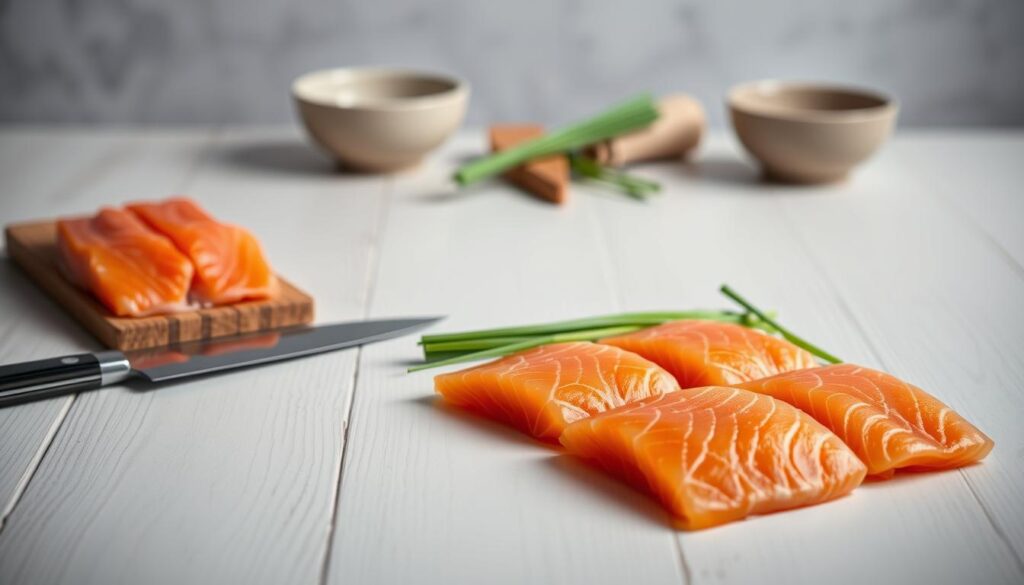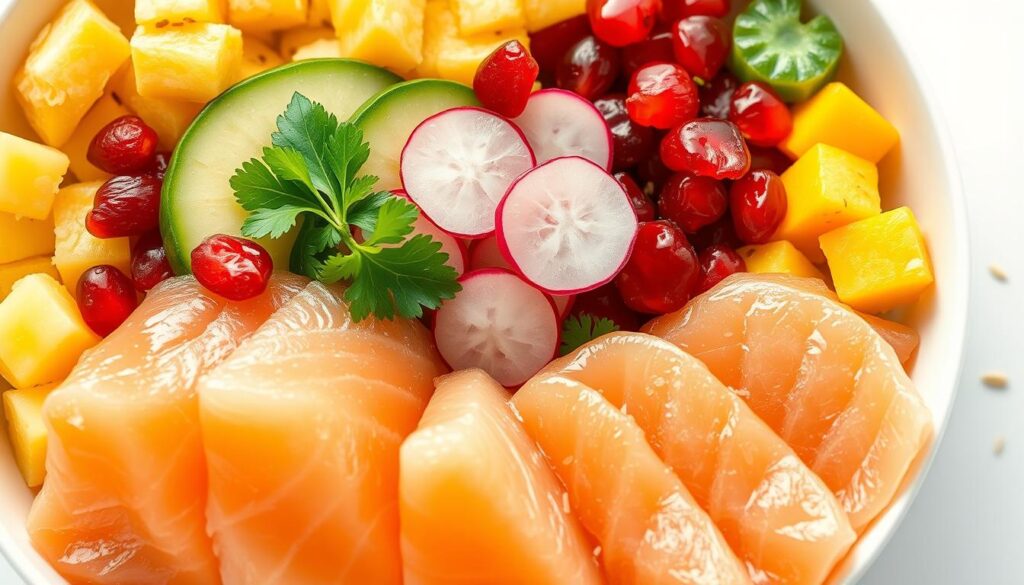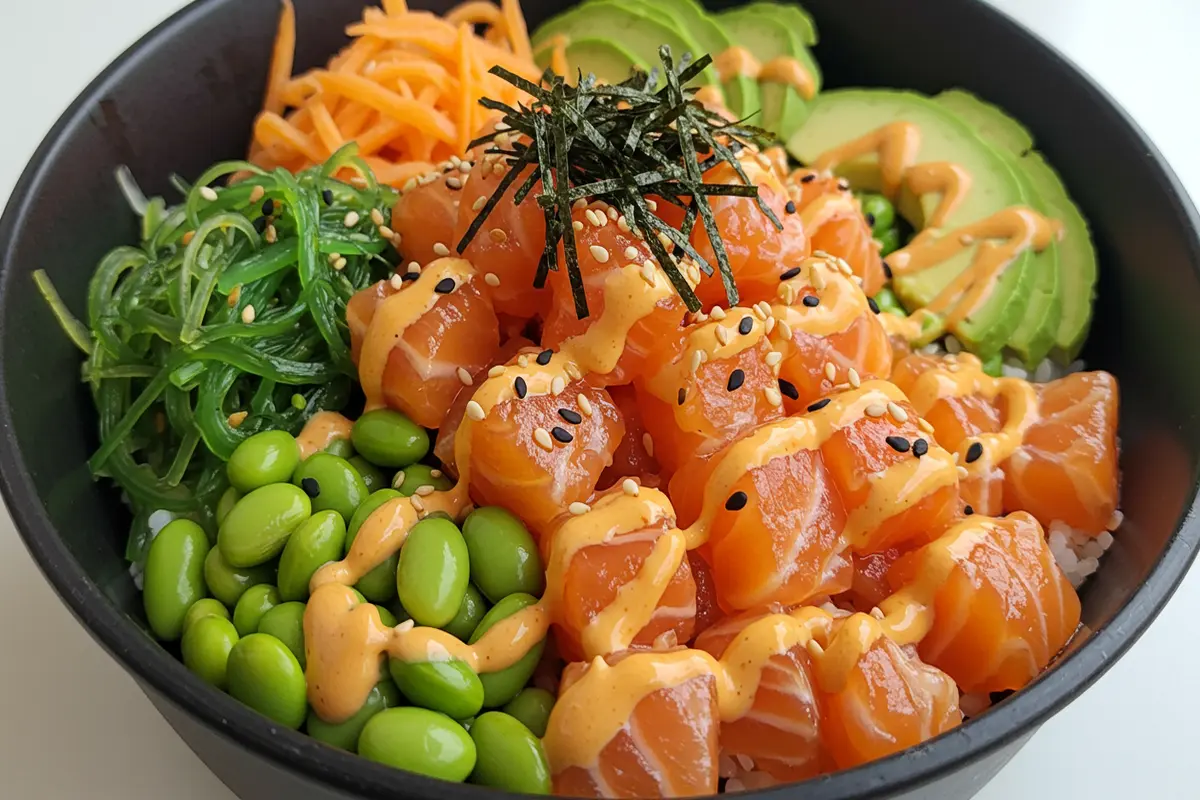The first time I tasted a salmon poke bowl, it was like experiencing a culinary sunrise. Fresh flavors danced on my palate, taking me to Hawaii’s vibrant shores. This dish is more than a meal; it’s an experience that turns simple ingredients into a taste symphony.
Making a salmon poke bowl at home might seem hard, but it’s not. With just 40 minutes of prep and a few fresh ingredients, you can make a dish as good as any restaurant’s.
Whether you’re an experienced cook or just starting, this salmon poke bowl recipe will be your new favorite. Let’s explore the world of Hawaiian-inspired cooking that’s both tasty and easy to make.
Table of Contents
Understanding Poke Bowl Basics and History
Poke is more than a raw fish salad. It’s a journey into Hawaiian cuisine and culture. The word “poke” means “to cut into pieces” in Hawaiian. This simple term hides the dish’s deep complexity.
The history of poke starts with Hawaiian fishermen. They made a quick snack from their day’s catch. These early salads were simple, with fresh fish, salt, seaweed, and kukui nuts.
Origins of Hawaiian Poke
Traditional poke was loved by Hawaiian seafood fans. Fishermen cut their catch into small pieces. This made a tasty and healthy dish.
- Raw fish cut into small cubes
- Minimal seasoning with natural ingredients
- Emphasis on freshness and local seafood
Evolution of Modern Poke Bowls
Poke changed as different cultures mixed. Ahi tuna and soy sauce from Japan made a big impact. Now, poke bowls are loved worldwide for their freshness and variety.
Cultural Significance
Poke is more than food; it’s a cultural bridge. Hawaii’s mix of America and Asia made poke a global hit. Today, poke bowls are a favorite for their healthiness and customizability.
Poke: A culinary journey from traditional Hawaiian fishing practice to worldwide dining sensation.
Essential Ingredients for Salmon Poke Bowl
Making a real salmon poke bowl starts with picking the best ingredients. You need top-notch sushi-grade fish for a safe and tasty dish. Let’s look at the main parts that make this dish special.
The key ingredients for your salmon poke bowl are:
- 8 ounces of fresh sushi-grade salmon
- Soy sauce (3 tablespoons)
- Sesame oil
- Rice vinegar
- Fresh aromatics like ginger and green onions
Choosing the best sushi-grade fish is key. The salmon should be very fresh, with bright color and firm texture. You can find the best fish at local markets or specialty stores.
| Ingredient | Quantity | Nutritional Impact |
|---|---|---|
| Salmon | 8 oz | 22g protein, 14g fat |
| Soy Sauce | 3 tbsp | 1250mg sodium |
| Sesame Oil | 1 tbsp | 14g fat |
Remember, freshness is crucial when making your poke bowl. Use your sushi-grade fish within 1-2 days for the best taste and safety. The right ingredients will make your homemade poke bowl truly amazing.
Selecting and Preparing Sushi-Grade Salmon
Making a great salmon poke bowl begins with picking the right fish. High-quality salmon is key for a tasty and safe dish. Knowing how to choose, store, and prepare your salmon will make your poke bowl taste like it’s from a restaurant.

Choosing Quality Sushi-Grade Fish
When picking sushi-grade fish, look for these important traits:
- Vibrant, fresh color with a mild ocean scent
- Firm, glossy flesh without discoloration
- Labeled specifically as sushi-grade or sashimi-grade
Proper Storage and Handling
Handling sushi-grade fish right is key to keeping it fresh and safe. Always buy from trusted places and follow these tips:
- Keep fish refrigerated at 40°F or below
- Use within 1-2 days of purchase
- Thaw in the refrigerator, never at room temperature
- Use immediately after thawing
Cutting Techniques for Perfect Cubes
To get the perfect salmon cubes, you need precision and the right method. Aim for ½-inch cubes for the perfect poke bowl bite.
| Salmon Variety | Texture | Recommended for Poke |
|---|---|---|
| Sockeye | Firm, lean | Excellent |
| King Salmon | Rich, buttery | Superior |
| Atlantic Salmon | Soft, fatty | Good |
Pro tip: Use a sharp knife and cut against the grain for the best texture and presentation of your sushi-grade salmon.
Creating the Perfect Poke Marinade
Making the perfect marinade is key to a tasty poke bowl. The right mix of ingredients can turn simple salmon into a flavor sensation. It’s all about creating a taste that excites your senses.
Start with the basics for a classic marinade:
- ¼ cup soy sauce for umami depth
- 2 tablespoons sesame oil for nuttiness
- 1 tablespoon rice vinegar for acidity
- 1 teaspoon honey for subtle sweetness
- 1 minced garlic clove for aromatic punch
- 1 teaspoon grated ginger for warmth
The secret to a great marinade is finding the right balance. Taste and adjust the mix to match your taste. Add ½ teaspoon of red pepper flakes for a spicy twist.
| Ingredient | Quantity | Purpose |
|---|---|---|
| Soy Sauce | ¼ cup | Provides umami and saltiness |
| Sesame Oil | 2 tablespoons | Adds nutty flavor |
| Rice Vinegar | 1 tablespoon | Brings brightness and acidity |
Timing is crucial when marinating seafood. Let your salmon marinate for 15-20 minutes. This develops flavors without overcooking the fish.
Pro tip: Use fresh, sashimi-grade salmon for the best poke bowl. The quality of your fish greatly affects the dish’s taste and safety.
Mastering the Art of Sushi Rice
Making perfect sushi rice is key to a great salmon poke bowl. High-quality sushi rice adds amazing flavor and texture. It’s the base of this tasty dish.
Sushi rice needs special care and techniques to become a culinary gem. Knowing how to prepare rice makes your poke bowl stand out.
Selecting the Right Rice
For sushi rice, pick short-grain Japanese rice. It’s different because of its stickiness, moisture, and ability to hold shape. It also absorbs flavors well.
Precise Washing Technique
Washing sushi rice is important for its texture. Here’s how to do it:
- Rinse rice gently in cold water
- Use a circular motion with your hand
- Continue rinsing 4-5 times
- Drain until water runs completely clear
Cooking and Seasoning
Cooking sushi rice right is crucial. Use a 1:1 rice-to-water ratio and cook for 15-20 minutes. Let it rest for 15 minutes after cooking.
Seasoning turns plain rice into sushi rice. The mix includes:
- 1/4 cup rice vinegar
- 2 tablespoons sugar
- 1 teaspoon salt
Mix these ingredients into the warm rice gently. Be careful not to mash the grains. Fan the rice while mixing to cool it and get a glossy finish.
Nutritional Insights
Your homemade sushi rice is nutritious:
- 360 calories
- 80g carbohydrates
- 6g protein
- 1g fat
By mastering sushi rice techniques, you’ll make a delicious base for your salmon poke bowl or your buddha bowl. It’s authentic and healthy.
Fresh Toppings and Accompaniments

Making a tasty salmon poke bowl is more than just the base and fish. The right toppings can make your dish amazing. Your poke bowl becomes a place for creativity, with each topping adding flavor and nutrition.
Here are some key fresh toppings to make your salmon poke bowl better:
- Seaweed salad: A vibrant green addition packed with minerals and a delightful texture
- Creamy avocado slices for healthy fats and smooth consistency
- Bright green edamame for protein and crunch
- Crisp cucumber rounds
- Pickled vegetables for tangy flavor
Each topping adds something special to your bowl. Seaweed salad brings a salty ocean taste, while avocado adds a creamy element. Edamame boosts protein and adds crunch. Mixing different textures and colors makes your meal look good and healthy.
Pro tip: Try new things. Add radishes for crunch, mango for sweetness, or pickled ginger for a zesty kick. Your poke bowl is a way to express your taste!
Building Your Salmon Poke Bowl
Making a salmon poke bowl is like art. It’s all about flavor, health, and looks. Your homemade bowl can be both tasty and Instagram-worthy.
Layer Arrangement Technique
The secret to a great salmon poke bowl is layering. Start with sushi rice, a neutral base. Then, add marinated salmon cubes as the main attraction.
- Begin with 2 cups of cooked sushi rice
- Add 8 ounces of sushi-grade salmon
- Arrange fresh vegetables in sections around the salmon
Portion Control Strategies
Keeping portions balanced is key for a healthy bowl. A serving has about 400-500 calories. Follow these tips for the right amount:
| Ingredient | Recommended Portion |
|---|---|
| Sushi Rice | 1/2 cup |
| Salmon | 3-4 ounces |
| Vegetables | 1 cup mixed |
| Garnishes | 1 tablespoon |
Visual Presentation Tips
Make your bowl look amazing by focusing on colors and arrangement. Cut veggies thinly and arrange them neatly. Add sesame seeds and green onions for a fancy finish.
A top-notch salmon poke bowl balances taste, texture, and looks. With a bit of practice, you’ll make bowls that rival restaurant quality at home.
Sauce Combinations and Garnishes
Make your salmon poke bowl stand out with exciting sauces and garnishes. The right sauce can change a simple dish into a masterpiece. It turns a regular meal into a special experience.
Choosing the right sauce is crucial for your salmon poke bowl’s taste. Here are some tasty options to try:
- Spicy Mayo: A creamy, zesty sauce that adds rich flavor
- Ponzu sauce for a citrusy tang
- Eel sauce for a sweet and savory note
Wasabi adds heat and complexity to your poke bowl. Start with 1 teaspoon of wasabi paste. Adjust to your liking. You can mix it into the sauce or serve it on the side for extra heat.
Garnishes add texture and depth to your dish. They also make it look great. Here are some popular choices:
- Furikake seasoning
- Toasted sesame seeds
- Fresh microgreens
- Thinly sliced green onions
When mixing sauces and garnishes, aim for balance. You want to enhance the salmon’s flavor without overpowering it. Try different combinations to find your favorite poke bowl.
Health Benefits and Nutritional Value
Your salmon poke bowl is more than just tasty—it’s full of nutrients. A single serving of salmon offers amazing health benefits. It makes this dish a great choice for those who care about their health.
Salmon, the main ingredient in your poke bowl, has a great nutritional profile:
- Rich in omega-3 fatty acids for heart and brain health
- Provides 18.8 grams of protein per 3-ounce serving
- Contains vital vitamins like B12, D, and B6
- Supports cognitive function and reduces inflammation
A salmon poke bowl is good for your health in many ways. It combines protein-rich fish, complex carbs, and fresh veggies. This mix supports your overall well-being. Choosing brown rice or greens as a base can also boost nutrition, cutting calories and increasing fiber.
Studies show eating fatty fish like salmon often can lower heart attack risks. A study with over 408,000 people found eating more fatty fish can cut down on heart problems by 5%.
A diet featuring salmon poke bowls might be your delicious pathway to better health!
Make your salmon poke bowl fit your diet needs. It works well with pescatarian, keto, or balanced diets. This versatile dish meets your nutritional goals.
Storage and Food Safety Guidelines
Making a tasty salmon poke bowl is more than just cooking. It’s about keeping food safe. Handling raw fish salad right is key to avoid health risks and keep it fresh.
Temperature control is crucial with raw fish salad. Your salmon poke should stay between 32°F to 38°F (0°C to 3°C). This range stops bacteria from growing and keeps your fish fresh.
Maximum Storage Timeframes
For safety, follow these storage tips for your raw fish salad:
- Freshly made poke: Store for up to 2 days
- Store-bought poke: Keep for up to 3 days
- Raw salmon poke: Eat within 1-2 days
Proper Container Selection
Use airtight containers for your salmon poke. They stop air from getting in and keep things clean. Always put your raw fish salad in the middle shelf of the fridge for even cooling.
Spoilage Detection
Look out for these signs that your raw fish salad might be bad:
- Dull or discolored look
- Smells like ammonia or too fishy
- Feels slimy
- Feels too hard or too soft
If you’re unsure, it’s better to be safe than sorry. Throw away any fish that looks or smells off. Your health is the most important thing when enjoying this tasty salad.
Conclusion
Making salmon poke bowls at home opens your kitchen to Hawaiian flavors. You’ve learned to pick the best salmon, make tasty marinades, and layer ingredients. This turns a simple meal into a celebration of taste and health. For more salmon recipes, try this delicious sushi bake.
Your poke bowl journey lets you be creative while honoring Hawaiian traditions. You can use different types of salmon, rice, and toppings. Each bowl is a unique way to enjoy Hawaiian food.
Creating the perfect poke bowl is about finding the right mix of flavors and freshness. Use top-notch ingredients and follow basic steps. Feel free to make changes to suit your taste. Every bowl you make brings Hawaiian cuisine closer to your home.
Share your poke bowl stories with others. It’s a fun way to share your love for cooking and Hawaiian food. It’s a great way to bond and explore the joy of cooking together.
FAQ
Q: What is a salmon poke bowl?
A: A salmon poke bowl is a dish from Hawaii. It has cubed raw salmon in a tasty sauce. It’s served over rice with fresh toppings like avocado and seaweed salad. It’s a healthy meal that mixes Hawaiian flavors with new tastes.
Q: Is it safe to eat raw salmon in a poke bowl?
A: Yes, but only with sushi-grade fish from a trusted source. Make sure the salmon is fresh and handled right. Buy it from places known for their food safety.
Q: How long can I store a salmon poke bowl?
A: For safety, eat your poke bowl within 24 hours. Keep it cold at 40°F or below. Store fish and ingredients separately to stay fresh.
Q: Can I substitute salmon with another type of fish?
A: Yes! Salmon is common, but poke often uses ahi tuna. You can also try yellowtail, trout, or cooked shrimp for a change.
Q: What makes a poke bowl authentic?
A: An authentic poke bowl uses fresh, high-quality fish and simple marinades. It includes traditional toppings like seaweed and rice. Modern poke bowls can be creative while staying true to their roots.
Q: Are poke bowls healthy?
A: Poke bowls are very healthy. Salmon has omega-3s, rice has carbs, and veggies add fiber. They’re a balanced meal for many diets.
Q: What kind of rice should I use for a poke bowl?
A: Traditional poke bowls use sushi rice. For a healthier choice, try brown rice or cauliflower rice. They keep the dish’s flavor and texture.
Q: How do I cut salmon for a poke bowl?
A: Use a sharp knife to cut the salmon into 1/2-inch cubes. Keep the fish cold and cut evenly. This makes the pieces easy to eat and look good.
Q: What are some popular poke bowl toppings?
A: Classic toppings are avocado, edamame, cucumber, and seaweed salad. Modern poke bowls might add crispy garlic, furikake, or tropical fruits like mango.
Q: Can I make a vegetarian poke bowl?
A: Yes! Use tofu or plant-based proteins like tempeh. Keep the dish’s structure with rice and veggies. It’s a tasty, meat-free option.

